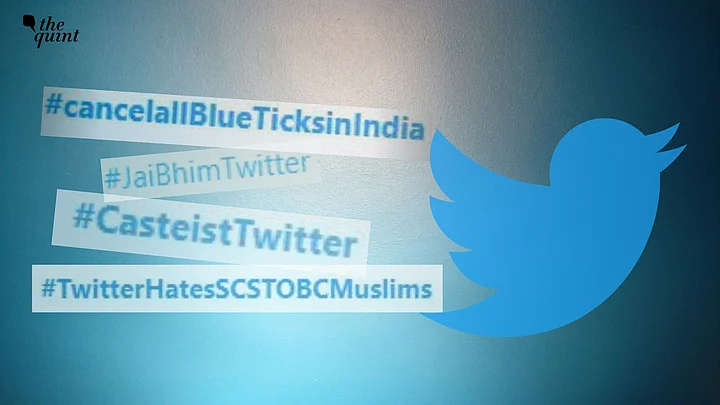Trends on Twitter in the last week tells a story of an unheard-of caste assertion and pride in India. Within a span of five days, activists from marginalised communities trended at least five top hashtags on Twitter alleging caste bias.
The “blue tick” on Twitter, which is considered a symbol of authenticity and massive reach, has come under fire with many alleging that it is accorded unfairly to those belonging to the upper castes.
On Wednesday, 6 November, #cancelallblueticksinIndia was the No 1 trend in India with more than 54,000 tweets accusing the platform of caste discrimination by suppressing the voices of the marginalised.
How the Campaign Started
The protests began after Twitter imposed restrictions on the account of Dilip Mandal, an adjunct professor at Makhanlal Chaturvedi National University of Journalism and Communication and a consulting editor at a news website. His suspension was considered, especially by users from marginalised communities, as oppression of the underprivileged castes and minorities at the hands of the micro-blogging platform.
Although his account was restored, the flurry of tweets followed under #CasteistTwitter, #JaiBhimTwitter, #TwitterHatesSCSTOBCMuslims, , #cancelallBlueTicksinIndia and #JaiBhimJaiPeriyar.
What Each of The Hashtags Stand For
The hashtag that took the campaign beyond the borders and made it trend globally as well as in India was #cancelallBlueTicksinIndia which asked Twitter to remove the verification tick from all profiles till it comes up with a more “transparent and socially fair policy for putting the blue tick beside a person’s name”.
Dilip Mandal, who was recently verified before being suspended from the site, told The Quint, “We don’t know what process Twitter follows for verifying people since it is not very transparent. But it creates a hierarchy in the conversation.”
A day after Mandal’s account was restored, on 2 November, people tweeting with #CasteistTwitter claimed that hundreds of activists, journalists and public personalities from the marginalised communities are not verified on Twitter despite having a base of huge followers.
The hashtag which trended on top all through the day also asked for the sacking of Manish Maheshwari, Twitter India’s MD. #SackManishMaheshwari which was also growing strength was mysteriously removed from the list of top trends.
On the same day, another hashtag #JaiBhimTwitter (Jai Bhim is a popular Dalit slogan) was also one of the top trends. “Jai Bhim” which literally means “Victory to Bhim”, referring to BR Ambedkar, reminded Twitter users of the principles propagated by the principal architect of the Constitution.
The movement which gained momentum within a matter of 5 days trended another hashtag on the top on Thursday, #JaiBhimJaiPeriyar that talked about the power that an united front of Ambedkar and Periyar have. Periyar is known as the “Father of the Dravidian Movement”.
Campaign Evokes Dalit-Bahujan Pride
Those driving the hashtags see it as a victory that the campaign could mobilise large chunks of people to trend on the top all through the week.
Supreme Court lawyer Nitin Meshram says the success of the campaign makes it clear that the “end to tolerance of inequality in India is near.”
Bhim Army Chief Chandrasekhar Azad said, “The constant ranking of trends show that when Dalits/Bahujans and other marginalised communities come together to raise their voices, it cannot go unnoticed.”
Data Shows Increasing Dalit Presence
The percentage of Dalits using Twitter daily or weekly increased from under 1 percent in 2014 to 5 percent in 2019, according to a survey conducted by Delhi-based Lokniti and Centre for the Study of Developing Societies (CSDS).
While there is no doubt that the usage of social media among SC/ST communities have gone up in the past few years, the space continues to be dominated by upper castes. According to the CSDS survey, upper castes are twice as likely to have high or moderate exposure to social media than Dalits and tribals.
The gap is even wider when it comes to not having any access to social media. While 75 percent tribals and 71 percent Dalits were found to have no social media exposure, this number was relatively lower for upper castes at 54 percent.
In such circumstances, the allegations of those belonging from the marginalised communities raising questions on Twitter’s verification process is significant.
How Did Twitter Respond?
Taking cognisance of the campaign, Twitter on Thursday denied the allegation and posted from its official account saying they have "one set of Twitter Rules".
“To be clear, whether it's the development of policies, product features, or enforcement of our Rules, we are impartial and do not take action based upon any ideology or political viewpoint,” Twitter said.
However, Twitter’s response was not convincing for many.
